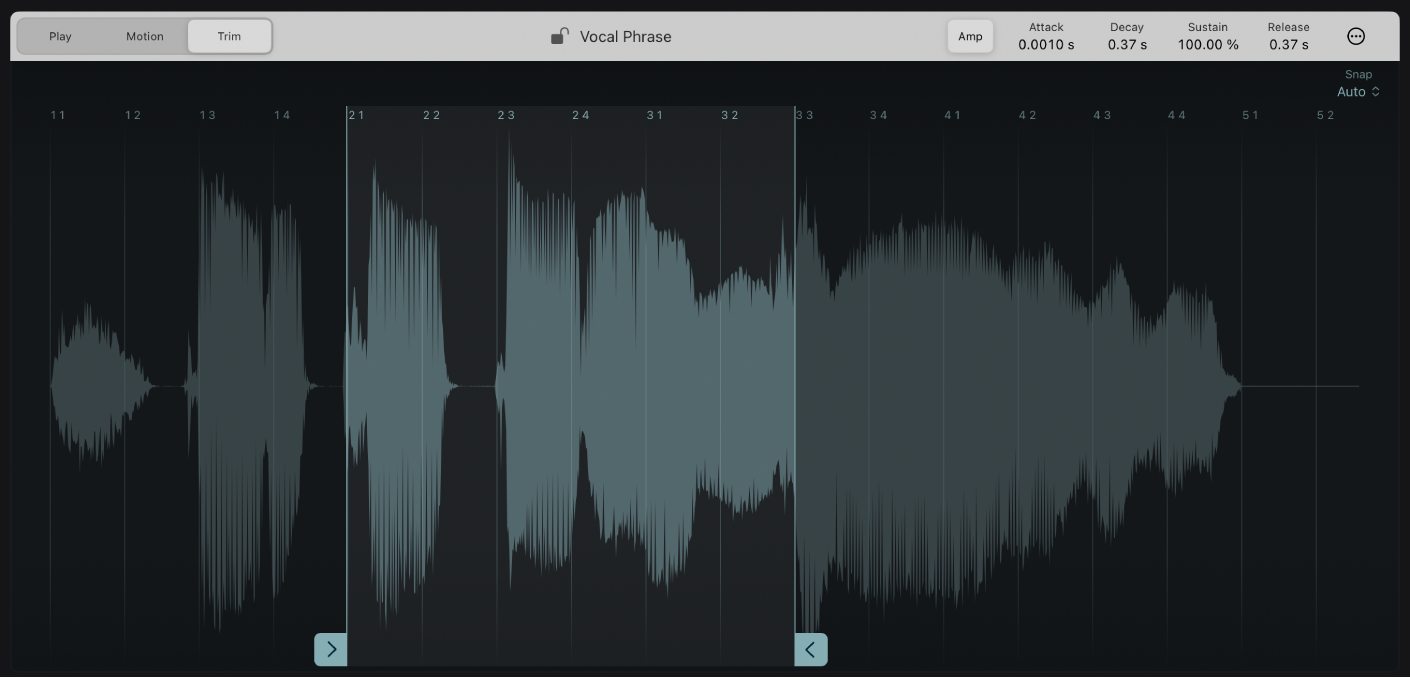Logic Pro User Guide for iPad
- What’s new in Logic Pro 1.1
-
- What is Logic Pro?
- Working areas
- Work with function buttons
- Work with numeric values
-
- Intro to tracks
- Create tracks
- Create tracks using drag and drop
- Choose the default region type for a software instrument track
- Select tracks
- Duplicate tracks
- Reorder tracks
- Rename tracks
- Change track icons
- Change track colors
- Use the tuner on an audio track
- Show the output track in the Tracks area
- Delete tracks
- Edit track parameters
- Start a Logic Pro subscription
- How to get help
-
- Intro to recording
-
- Before recording software instruments
- Record software instruments
- Record additional software instrument takes
- Record to multiple software instrument tracks
- Record multiple MIDI devices to multiple tracks
- Record software instruments and audio simultaneously
- Merge software instrument recordings
- Spot erase software instrument recordings
- Replace software instrument recordings
- Capture your most recent MIDI performance
- Use the metronome
- Use the count-in
-
- Intro to arranging
-
- Intro to regions
- Select regions
- Cut, copy, and paste regions
- Move regions
- Remove gaps between regions
- Delay region playback
- Trim regions
- Loop regions
- Repeat regions
- Mute regions
- Split and join regions
- Stretch regions
- Separate a MIDI region by note pitch
- Bounce regions in place
- Change the gain of audio regions
- Create regions in the Tracks area
- Convert a MIDI region to a Drummer region or a pattern region
- Rename regions
- Change the color of regions
- Delete regions
- Create fades on audio regions
- Access mixing functions using the Fader
-
- Intro to Step Sequencer
- Use Step Sequencer with Drum Machine Designer
- Record Step Sequencer patterns live
- Step record Step Sequencer patterns
- Load and save patterns
- Modify pattern playback
- Edit steps
- Edit rows
- Edit Step Sequencer pattern, row, and step settings in the inspector
- Customize Step Sequencer
-
- Effect plug-ins overview
-
- Instrument plug-ins overview
-
- ES2 overview
- Interface overview
-
- Modulation overview
-
- Vector Envelope overview
- Use Vector Envelope points
- Use Vector Envelope solo and sustain points
- Set Vector Envelope segment times
- Vector Envelope XY pad controls
- Vector Envelope Actions menu
- Vector Envelope loop controls
- Vector Envelope release phase behavior
- Vector Envelope point transition shapes
- Use Vector Envelope time scaling
- Use the Mod Pad
- Modulation source reference
- Via modulation source reference
-
- Sample Alchemy overview
- Interface overview
- Add source material
- Save a preset
- Edit mode
- Play modes
- Source overview
- Synthesis modes
- Granular controls
- Additive effects
- Additive effect controls
- Spectral effect
- Spectral effect controls
- Filter module
- Low and highpass filter
- Comb PM filter
- Downsampler filter
- FM filter
- Envelope generators
- Mod Matrix
- Modulation routing
- Motion mode
- Trim mode
- More menu
- Sampler
- Copyright
Sample Alchemy Trim mode in Logic Pro for iPad
Trim mode lets you select the exact part of the sample you want to use. You can see the current audio file in the waveform display and directly trim the sample using markers. You can zoom in or out with pinch gestures or scroll using single or two-finger swipes. When you zoom in, the scroll bar indicates the current position within the waveform.
When you tap or drag markers and handles in the waveform display, you can trim the waveform more accurately by choosing a Snap value, which allows you to snap the markers to a transient or beat.

Trim mode parameters
Start and end markers: Drag the blue start or the end marker to set the sample start and end points. Playback occurs between these markers.
Snap pop-up menu: Choose a Snap value. In play modes and Motion mode, this affects the movement of source handles. In Trim mode, the Snap value affects edits to loop start and end markers in the waveform display. The following options are available in the Snap pop-up menu:
Auto: The Snap value is automatically set to the best value based on the selected mode and the sample.
Off: Turn snap off.
Transients: Snap to transients in the sample.
Beat: Snap to beat values in the sample.
Fixed: Set the Snap value to allow source handles to move only on the Y axis (vertically) in play modes and Motion mode.
Zoom in/out: Use the pinch gesture to zoom in and out.
Set trim start and end markers
To set the start and end markers in Trim mode, do any of the following:
Tap the Snap menu and choose a Snap value.
Tap the start marker, then drag it left or right to set the start position of the sample.
Tap the end marker, then drag it left or right to set the end position of the sample.
Note: You can pinch the waveform to zoom in and out for more precise editing. If you zoom in to the waveform, swipe to the left or right to see the start or end markers.
Download this guide: PDF